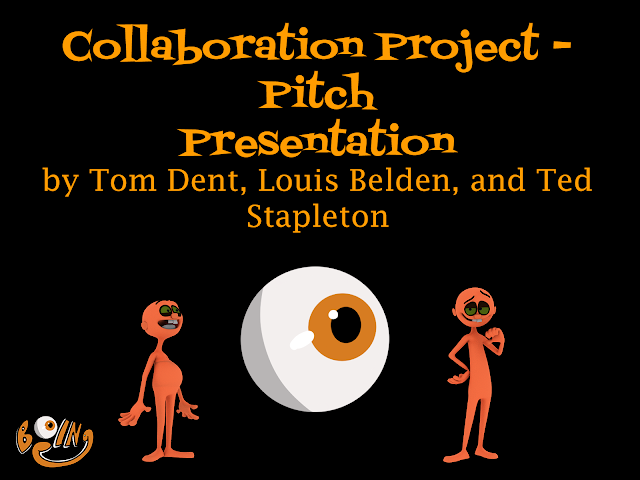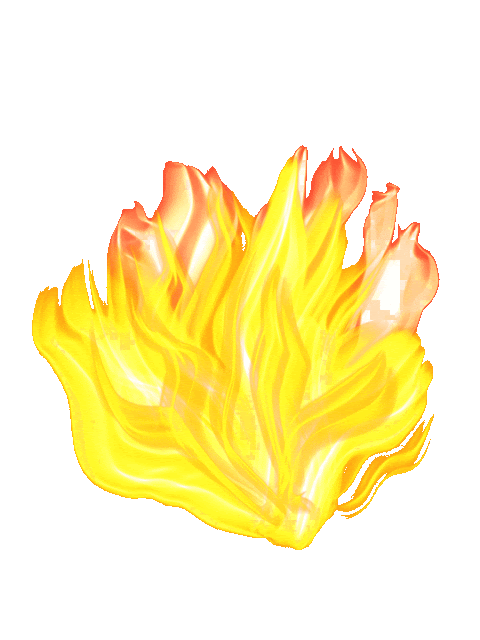Collaboration Pitch Presentation - OGR 21/10/2019
Additional: Initial skit ideas
A rough layout demonstrating the theme/'vibe' of our short. The skits will be relatively fast paced, taking about 5-20 seconds each. If the longer skits take too long, they may have to be cut down or removed. Therefore, this section is in its early stages and likely to change. Individual skits may be switched out for others, or new ones added on.
>------------------- [Fade In]
INTRO: The characters need to be introduced quickly to keep
the short within the time budget, so I suggest an intro shot that opens onto
the stage, with the five characters posing in darkness. The Narrator begins; "Introducing… ‘Staying safe in the workplace’! An Amateur Stage Society
production starring…" The narrator then announces each of the five characters by name,
with the spotlight illuminating each one for 1-2 seconds in which they each
perform a short animation that defines their personality. The short then moves
onto the first skit.
The transitions between skits can be a quick drawing of the stage curtain, and re-opening (even when it makes no sense in terms of time for the set and characters to have changed in a couple of seconds, it’s cartoon logic and necessary to keep the short snappy)
The transitions between skits can be a quick drawing of the stage curtain, and re-opening (even when it makes no sense in terms of time for the set and characters to have changed in a couple of seconds, it’s cartoon logic and necessary to keep the short snappy)
>------------------- [Transition]
SKIT 1 (SHAKE): Shake and some extras (or possibly another of the five actors) demonstrate first aid for an
injury in the workplace. Shake over-acts the minor injury and the extras
(playing his co-workers/medics), have to get aggressive in restraining him so
they can play their part, eventually accidentally knocking him off stage and
giving him an actual injury. He appears in the next scene with a head-bandage.
>------------------- [Transition]
SKIT 2 (MIKE & DIM): Mike and Dim are brought up to demonstrate
how to keep corridors and walkways clear of dangerous objects and trip hazards.
A simple factory/lab styled corridor is set up, and a variety of dangerous
items are strewn across it (broken glass, wires, chemical bottles, hot drinks,
banana peels, etc). Dim is asked by the narrator to demonstrate clearing the
walkway, which he does gleefully, but realises he has nowhere to put the items.
Improvising, he nonchalantly chucks them to the left, off stage (where there is
a set of steps up to the stage floor). Meanwhile, Mike has been posing and
flexing, preparing for his big moment.
As the spotlight shines on him, he poses, and
anti-climatically strolls a few feet across the walkway, and poses again at the
end. He turns the audience and bows dramatically for his performance. The
narrator starts to wrap up by stressing the importance of checking for hazards on
walkways and clearing them, while Mike, still waving and smiling at the
audience, starts down on the steps. He trips on the junk thrown by Dim, falls off
stage behind the curtain, and we see a crash of debris as he lands in the huge
pile of hazardous items at the bottom of the stairs.
>------------------- [Transition]
SKIT 3 (SHAKE & POP): Shake (with head bandage) and Pop are called upon by the narrator
to demonstrate proper waste disposal etiquette. Shake melodramatically plays
the role of a factory worker. Pop reluctantly plays the role of some pedal
bins. The two pedal bins (recycling and non-recycling) are cardboard props,
where the opening of the lid is activated by Pop, who is sitting bitterly
behind the bins near the edge of the stage with two spring-loaded pedals. Shake
is the actor that Pop hates the most, since they are polar opposites, and Pop
despises Shakes over-enthusiasm for acting.
Shake dramatically poses and holds up a waste item. The
narrator asks the audience a rhetorical question regarding which bin it should
end up in. Shake then does an incredibly over-dramatic and unnecessarily long ballet
style series of prances over to the bins, and holds it over one of them. Pop,
clearly annoyed, rolls his eyes and passive aggressively moves a single finger to open the
pedal bin.
For 'dramatic effect', Shake decides to hover the item above each bin interchangeably, convolutedley pretending to drop the item each time before switching to the other. Pop keeps having to lean from side to side to open the bins, and eventually snaps, and hunches up in a huff.
For 'dramatic effect', Shake decides to hover the item above each bin interchangeably, convolutedley pretending to drop the item each time before switching to the other. Pop keeps having to lean from side to side to open the bins, and eventually snaps, and hunches up in a huff.
Shake drops the item, and it bounces awkwardly off the bin's lid. Shake, finding Pop's lack of performance disturbing, leans over the bin and taps the lid impatiently to get Pops attention. Seeing an opportunity, Pop
turns round and slams the pedal for the left-hand bin, the lid flying up and
smacking Shake in the Jaw. Shake breaks character and clasps his jaw, making muffled
yells, but loses balance on the block he’s standing on to reach the bins, and
falls into one.
>------------------- [Transition]
SKIT 4 (MEL): Mel is brought up to demonstrate staying safe around a fire and extinguishing it. A small but real flame is lit on a prop-electrical outlet. Mel is standing disinterestedly with a fire-extinguisher waiting for his que to put it out, but his phone
vibrates in his pocket, causing him to become distracted with answering a text.
The narrator gets more and more anxious as the flame starts to grow larger than had been expected, repeatedly announcing Mel’s intervention. Mel puts his finger up, signalling he’s almost done. The flame catches on one of the stage curtains, and instantaneously the whole curtain bursts into flames. Mel is still texting. Possible ending, since it could destroy the stage and cause everyone except Mel to evacuate (who is still texting amongst the burning stage).
The narrator gets more and more anxious as the flame starts to grow larger than had been expected, repeatedly announcing Mel’s intervention. Mel puts his finger up, signalling he’s almost done. The flame catches on one of the stage curtains, and instantaneously the whole curtain bursts into flames. Mel is still texting. Possible ending, since it could destroy the stage and cause everyone except Mel to evacuate (who is still texting amongst the burning stage).
>------------------- [END]





There are positives and negatives to your OGR. Under the surface there is a series of good ideas, however…
ReplyDeleteOGR Submission –
I found your document ‘frustrating’ for several reasons. Firstly, it’s not a presentation document, it’s a ‘fragmented’ blogpost – Three graphically designed pages and an ‘additional’ text section. Secondly, the pages are very hard to read because the text is competing with effects and the background (graphically over-designed). Thirdly, in terms of amount of work, your OGR is a somewhat ‘light’ on content. A little disappointing given the positive discussion we had.
Your skits -
Overall, I think your skits/animated short is a little too complicated to let your audience in on the jokes. What I mean by that is, by having five characters, complex personality traits, a workplace PSA, a town hall, a narrator, long skits, curtains/titles it could become confusing for the audience very quickly because you don’t have a lot of time to explain things. The secret to this project is to make your set-up as simple and as clean as possible so that you can play with the audiences’ expectations.
For example, instead of having five characters you should have three (like the three stooges). They should all be on stage at the same time throughout. In the first skit you should demonstrate/explain their personalities so that the audience knows what to expect next – You can also do that through design. Then once the audience knows you can play with that dynamic and their expectations.
It’s unlikely that you would need a narrator unless the format specifically requires it. Like in a children’s show or a training video. If you do want to use a narrator, then he/she should be speaking throughout the film - A narrator is another character (see link below) but it will mean changing the format/setting.
In this case titles between each segment would be enough so that you can focus on silent comedy. To make that logical, you could decide that your acting troops ‘gimmick’ is that they only do ‘pure acting’ and no dialogue – A ‘pretentious’ acting decision that always leads them to fail. A ‘normal’ troop would just use their voices etc. You wouldn’t need to make a big thing about that, just enough so the audience understands, such as ‘The Silent Player’s Present…’.
Overall, the genesis of your skit ideas are fine, but they will need altering to fit a less cluttered setup. Regardless, come and see me on Thursday so we can discuss this more.
Link – (note, watch this all the way through to the end. Its not a kids show!)
https://www.youtube.com/watch?v=HsCY47b-Zic